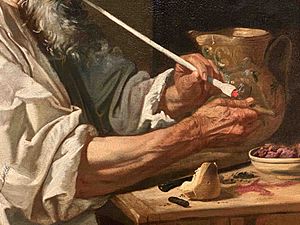Smoking pipe facts for kids

A smoking pipe is a tool designed to hold and burn plant materials, most commonly tobacco. People use pipes to enjoy the smoke. Pipes are often made from materials like briar wood, heather, corn cobs, meerschaum, clay, cherry wood, glass, porcelain, ebonite, and acrylic.
History of Pipes in the Netherlands
During the 1600s, using pipes became very popular in the Netherlands. This trend was especially big among young people from wealthy and middle-class families. These students saw Spanish sailors and soldiers using pipes and started to copy them.
They were interested in this new way to enjoy tobacco. At that time, pipes were the main way to use tobacco. Soon, pipes became a common habit for many Dutch people. The Dutch Republic quickly changed from a country where few people used tobacco to one where many enjoyed it. This happened in a short time, between 1590 and 1650.
Where People Used Pipes
Young people often used their pipes in special rooms called "smoking rooms" or "tobacco houses." It was a social activity, and they usually used pipes with friends. It took over a hundred years for this practice to become truly fashionable.
Pipes in Art
The growing popularity of pipes also caught the eye of artists. Even though pipes were once seen as something for the lower class, they became a sign of importance and style. You can find pipes in many paintings from that time.
For example, in a painting called The Merry Company (around 1620-1622) by Willem Buytewech, you can see a tobacco pipe on a table. Three young men and a woman are sitting around it. Another artist, Adriaen Brouwer, also showed interest in pipes. In his painting The Smokers (1636), the people in the picture are shown with their pipes.
bs:Lula ko:파이프 담배 hr:Lula hu:Pipa


